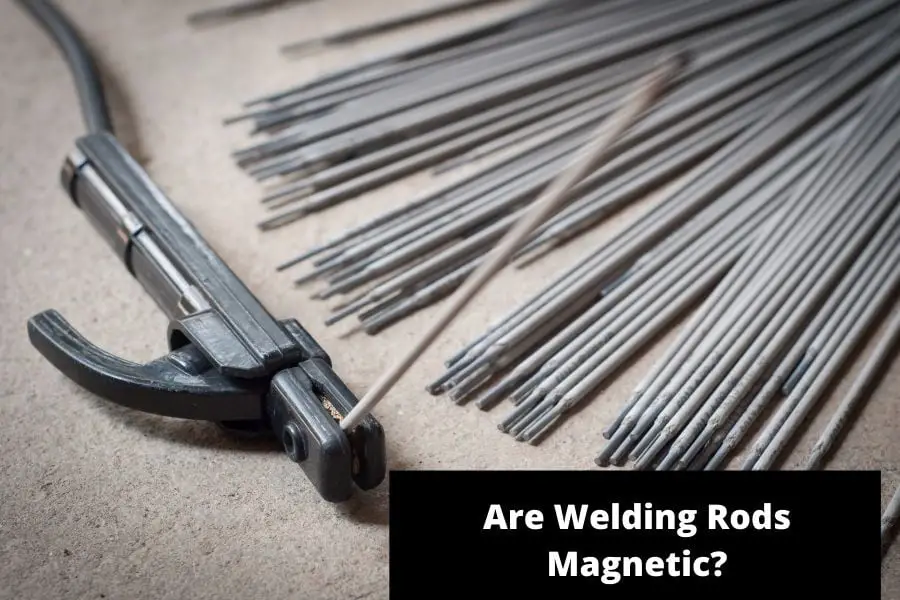
Welding rods come in many types and sizes, and they each have their distinct qualities. Some have higher penetration ratings, while others have technique-based variations. Welders often have to weld on magnetized base metal, so people are often curious, are welding rods magnetic?
Most welding rods are magnetic. Magnets or magnetized metal can attract them and mess with the welding process. Anything that has iron or other magnetic metal in it would exhibit some magnetic qualities.
People primarily express their concerns about magnetism when talking about arc welding and magnetic arc blow. A magnetic arc blow can cause welding path deviation, which will make a mess out of the base metal you are working on. Naturally, there are ways of solving this issue, and I’ll cover those in the following section.
Do Welding Rods Have Magnetic Properties?
Different welding rods are made off of different materials, and each has its layer of coating. Iron powder increases the volume of the weld by adding extra metal to the pool. Manganese or Iron oxide coatings can help adjust a slag’s fluidity by helping it stabilize faster.
The electrodes or welding rods have different polarities based on their manufacturing condition and storage conditions. They can also develop magnetism if you expose them to other magnets for too long.
The heavy use of magnetic metal in the initial manufacturing process ensures that most of these rods are magnetic. That is why people face problems while welding magnetized material with arc welding.
Ferrite is another crucial part of a welding rod. that determines some of its characteristics like overall toughness. The amount varies depending on the service temperature of the weld. It also helps prevent cracks in austenitic stainless. But ferrite is also magnetic, so it plays a big role in causing magnetic issues in the welding process.
Should You Care About Welding Rods Being Magnetic?
By now, you know that most welding rods are either magnetic or acquired external magnetism. They also often change their polarity depending on the storage condition and the material they come into contact with. Now the question is, do you even need to care about all this?
The magnetic property of a welding rod makes it susceptible to the effects of artificial magnetic fields. The arc welding process often creates the required conditions for a small-scale magnetic field. That can cause a magnetic arc blow or an arc deflection.
There are two types of arc blows, thermal and magnetic. Both types cause deformities in the finished weld, but here I will only cover the magnetic version. The magnetic field of the ferromagnetic material could cause the weld bead to distort out of its position. This effect gets worse if your welding rod also has unspecified magnetism.
However, this phenomenon is not entirely the fault of the welding rod. The joint design, weld settings, atmospheric conditions, and the welder’s techniques play a bigger role in this case. But if the welding rod has strong enough innate magnetism, it could cause more harm.
How To De-Magnetize Base Metal?
If magnetism is such a bad thing for arc welding, then what do people do to circumvent the issue? The answer lies in the process of demagnetizing. Most welders use it as a last resort. The process of degaussing a piece of metal is more troublesome than it’s worth. Many welders can solve it through better welding techniques, but that does not work on some metals.
Demagnetization also goes by the name of degaussing (source). There are many ways of degaussing a metal, but the result generally depends on the quality of the tools you use for the process. In simple terms, degaussing is randomly altering a metal’s magnetic region.
You could demagnetize something with a welding power supply, powerful magnet, excessive heat, or impact. You only need to alter the magnetic polarity during the welding process, so the degaussing does not need to be permanent. Most welders only partially degauss their metal because lingering magnetism is more or less inconsequential.
That is why most people would degauss the metal right before welding. That will ensure the maximum effectiveness and the least amount of hassle. There are a few ways to do it, so I’ll list them below:
1. Heat Treating
Heat treating is the crudest and one of the oldest forms of degaussing techniques. High heat can remove the magnetic force from any metal as long as you can reach the right temperature. The heat-treating process is officially known as curing, named after the guy who invented the system, Pierre Curie.
The temperature requirement varies depending on the metal. It becomes easier once you identify the threshold. The curing temperature for iron is 770°C (source). At this temperature, the iron goes through a polarity change that removes the magnetic effects.
Curing is a delicate procedure, and you need to control the temperature accurately. The metal will not cure without reaching the required temperature. On the other hand, you might end up ruining your metal by going above the threshold.
The cooling process is one of the most crucial parts of curing. You must let the metal cool down in an environment that does not have a strong magnetic field. Otherwise, all the work you just did will go down the drain.
2. Use a Degausser
AS the name suggests, the degausser is a modified tool for demagnetizing metal. It works by running electricity through a coil wire to alter the polarity of the target. You could call it a magnetic field generator that nullifies the surrounding inferior magnetic fields and magnetized objects.
It comes in many shapes and sizes because welders need to use it on various objects with mismatched sizes and orientations. There are small hand-held ones for smaller small metal pieces and large industrial-grade ones for professional works.
3. Welding Power Supply
What to do if you don’t have a fancy degausser? That thing is ultimately a power box with a metal ring on it, something anyone can easily recreate as long as they have access to a suitable power source.
Lucky for you, a welding power supply works perfectly for this job. You just need to make a coil with a welding cable or other suitable conductor and copy a degausser. It is a bit dangerous, but it works fine if you are careful enough.
AC is the more error-free power source for this job. I can demagnetize metals up to 2 inches thick. You would need to worry about the polarity issues with a DC source though. You need to create a magnetic field that has an opposite direction as the metal you are trying to demagnetize.
4. Electromagnet
If you think the above methods are too dangerous then try using a powerful electromagnet. The magnetic field generated by a powerful electromagnet can nullify the magnetism from regular metal.
I suggest getting an electromagnet that uses an AC power Source, as that is the safest way to go. But the limitation of an AC-powered magnet is that it does not work on thick metal. DC works well on thicker metal, but you need to align the field in the opposite direction.
Conclusion
So, are welding rods magnetic? Yes, they mostly are magnetic. Some of them even have magnetism acquired from other sources. They don’t have a monumental effect on arc welding, but the effect is not negligible either.
Thanks for reading till now. I hope this write-up was able to understand the magnetic effects of welding rods, why you should care about it, and how to deal with it.

